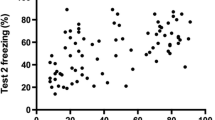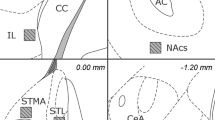Abstract
Rationale
Previous results indicate that peripheral administration of secretin leads to robust Fos protein expression in the central nucleus of the rat amygdala. The implications of this observation on rat brain function, if any, remain unclear.
Objectives
We examined the effect of systemic secretin administration on the expression of fear-potentiated startle in rats, a behavioral response known to require an intact, functional central nucleus of the amygdala.
Methods
Rats were trained to associate a neutral light conditioned stimulus (CS) with footshock, a fear-inducing unconditioned stimulus (US). Twenty-four hours later, rats were administered secretin or vehicle and were tested immediately for their startle response to a loud noise in the presence or absence of the light.
Results
Within a dose range relevant to its clinical use in autistic children, secretin dose-dependently decreased the magnitude of fear-potentiated startle in rats.
Conclusions
This investigation provides additional evidence that systemically administered secretin can influence a neural network implicated in the acquisition and expression of emotional behaviors, including fear and anxiety.


Similar content being viewed by others
References
Abell F, Krams M, Ashburner J, Passingham R, Friston K, Frackowiak R, Happe F, Frith C, Frith U (1999) The neuroanatomy of autism: a voxel-based whole brain analysis of structural scans. Neuroreport 10:1647–1651
Asmann YW, Dong M, Ganguli S, Hadac EM, Miller LJ (2000) Structural insights into the amino-terminus of the secretin receptor: I. Status of cysteine and cystine residues. Mol Pharmacol 58:911–919
Babu GN, Vijayan E (1983) Plasma gonadotropin, prolactin levels and hypothalamic tyrosine hydroxylase activity following intraventricular bombesin and secretin in ovariectomized conscious rats. Brain Res Bull 11:25–29
Banks WA, Goulet M, Rusche JR, Niehoff ML, Boismenu R (2002) Differential transport of a secretin analog across the blood-brain and blood-cerebrospinal fluid barriers of the mouse. J Pharmacol Exp Ther 302:1062–1069
Baron-Cohen S, Ring HA, Bullmore ET, Wheelwright S, Ashwin C, Williams SC (2000) The amygdala theory of autism. Neurosci Biobehav Rev 24:355–364
Bauman M, Kemper TL (1985) Histoanatomic observations of the brain in early infantile autism. Neurology 35:866–874
Bauman ML, Kemper TL (1994) Neuroanatomic observations of the brain in autism. In: Bauman ML, Kemper TL (eds) The neurobiology of autism. John Hopkins University Press, Baltimore, pp 119–145
Bayliss WM, Starling EH (1902) The mechanism of pancreatic secretion. J Physiol 28:325–353
Beck CHM, Fibiger HC (1995) Conditioned fear-induced changes in behavior and in the expression of the immediate early gene c-fos: with and without diazepam pretreatment. J Neurosci 15:709–720
Cassella JV, Davis M (1986) The design and calibration of a startle measurement system. Physiol Behav 36:377–383
Coniglio SJ, Lewis JD, Lang C, Burns TG, Subhani-Siddique R, Weintraub A, Schub H, Holden EW (2001) A randomized, double-blind, placebo-controlled trial of single-dose intravenous secretin as treatment for children with autism. J Pediatr 138:649–655
Courchesne E (1991) Neuroanatomic imaging in autism. Pediatrics 87:781–790
Davis M (1979) Diazepam and flurazepam: effects on conditioned fear as measured with the potentiated startle paradigm. Psychopharmacology 62:1–7
Davis M (2000) The role of the amygdala in conditioned and unconditioned fear and anxiety. In: Aggleton JP (ed) The amygdala (vol 2) Oxford University Press, Oxford, pp 213–287
Davis M, Falls WA, Campeau S, Kim M (1993) Fear-potentiated startle: a neural and pharmacological analysis. Behav Brain Res 58:175–198
Davis M, Whalen P (2001) The amygdala: vigilance and emotion. Mol Psychiatr 6:13–34
Fremeau RT, Jensen RT, Charlton CG, Miller RL, O’Donohue TL, Moody TW (1983) Secretin: specific binding to rat brain membranes. J Neurosci 3:1620–1625
Fremeau RT, Korman LY, Moody TW (1986) Secretin stimulates cyclic AMP formation in the rat brain. J Neurochem 46:1947–1955
Fuxe K, Andersson K, Hokfelt T, Mutt V, Ferland L, Agnati LF, Ganten D, Said S, Eneroth P, Gustafsson JA (1979) Localization and possible function of peptidergic neurons and their interactions with central catecholamine neurons, and the central actions of gut hormones. Fed Proc 38:2333–2340
Goulet M, Shiromani PJ, Ware CM, Strong RA, Boismenu R, Rusche J (2003) A secretin I.V. infusion activates gene expression in the central amygdala of rats. Neuroscience 118:881–888
Horvath K, Stefanatos G, Sokolski KN, Wachtel R, Nabors L, Tildon J T (1998) Improved social and language skills after secretin administration in patients with autistic spectrum disorders. J Assoc Acad Minor Physicians 9:9–15
Howard MA, Cowell PE, Boucher J, Broks P, Mayes A, Farrant A, Roberts N (2000) Convergent neuroanatomical and behavioural evidence of an amygdala hypothesis of autism. Neuroreport 11:2931–2935
Ishihara T, Nakamura S, Kaziro Y, Takahashi T, Takahashi K, Nagata S (1991) Molecular cloning and expression of a cDNA encoding the secretin receptor. EMBO J 10:1635–1641
Itoh N, Furuya T, Ozaki K, Ohta M, Kawasaki T (1991) The secretin precursor gene. Structure of the coding region and expression in the brain. J Biol Chem 266:12595–12598
Kopin AS, Wheeler MB, Nishitani J, McBride EW, Chang TM, Chey WY, Leiter AB (1991) The secretin gene: evolutionary history, alternative splicing, and developmental regulation. Proc Natl Acad Sci USA 88:5335–5339
Lan MS, Kajiyama W, Donadel G, Lu J, Notkins AL (1994) cDNA sequence and genomic organization of mouse secretin. Biochem Biophys Res Commun 200:1066–1071
LeDoux JE (2000) The amygdala and emotion: a view through fear. In: Aggleton JP (ed) The amygdala and emotion: a view through fear. Oxford University Press, New York, pp 289–310
Leiter AB, Chey WY, Koplin AS (1993) Secretin. In: Walsh JH, Dockray G (eds) Gut peptides. Raven Press, New York, pp 147–174
Lu Y, Owyang C (1995) Secretin at physiological doses inhibits gastric motility via a vagal afferent pathway. Am J Physiol 268:1012–1016
Mutt V (1980) Secretin: isolation, structure and function. In: Glass GBJ (ed) Gastrointestinal hormones. Raven Press, New York, pp 85–126
Ng SS, Yung WH, Chow BK (2002) Secretin as a neuropeptide. Mol Neurobiol 26:97–107
Nozaki S, Nakata R, Mizuma H, Nishimura N, Watanabe Y, Kohashi R (2002) In vitro autoradiographic localization of (125)i-secretin receptor binding sites in rat brain. Biochem Biophys Res Commun 292:133–137
Propst F, Moroder L, Wunsch E, Hamprecht B (1979) The influence of secretin, glucagon and other peptides, of amino acids, prostaglandin endoperoxide analogues and diazepam on the level of adenosine 3’,5’-cyclic monophosphate in neuroblastoma×glioma hybrid cells. J Neurochem 32:1495–1500
Rasia-Filho AA, Londero RG, Achaval M (2000) Functional activities of the amygdala: an overview. J Psychiatr Neurosci 25:14–23
Roberts W, Weaver L, Brian J, Bryson S, Emelianova S, Griffiths AM, MacKinnon B, Yim C, Wolpin J, Koren G (2001) Repeated doses of porcine secretin in the treatment of autism: a randomized, placebo-controlled trial. Pediatrics 107:E71
Samson WK, Lumpkin MD, McCann SM (1984) Presence and possible site of action of secretin in the rat pituitary and hypothalamus. Life Sci 34:155–163
Sandler AD, Sutton KA, DeWeese J, Girardi MA, Sheppard V, Bodfish JW (1999) Lack of benefit of a single dose of synthetic human secretin in the treatment of autism and pervasive developmental disorder. N Engl J Med 341:1801–1806
Segre GV, Goldring SR (1993) Receptors for secretin, calcitonin, parathyroid hormone (PTH)/PTH-related peptide, vasoactive intestinal peptide, glucagon-like peptide 1, growth hormone-releasing hormone, and glucagon belong to a newly discovered G-protein linked receptor family. Trends Endocrinol Metab 4:309–314
Ulrich CD, Pinon DI, Hadac EM, Holicky EL, Chang-Miller A, Gates LK, Miller LJ (1993) Intrinsic photoaffinity labeling of native and recombinant rat pancreatic secretin receptors. Gastroenterology 105:1534–1543
van Calker D, Muller M, Hamprecht B (1980) Regulation by secretin, vasoactive intestinal peptide, and somatostatin of cyclic AMP accumulation in cultured brain cells. Proc Natl Acad Sci USA 77:6907–6911
Walker DL, Davis M (2002) Quantifying fear potentiated startle using absolute versus proportional increase scoring methods: implications for the neurocircuitry of fear and anxiety. Psychopharmacology 164:318–328
Whitmore TE, Holloway JL, Lofton-Day CE, Maurer MF, Chen L, Quinton TJ, Vincent JB, Scherer SW, Lok S (2000) Human secretin (SCT): gene structure, chromosome location, and distribution of mRNA. Cytogenet Cell Genet 90:7–52
Yung WH, Leung PS, Ng SS, Zhang J, Chan SC, Chow BK (2001) Secretin facilitates GABA transmission in the cerebellum. J Neurosci 21:7063–7068
Acknowledgement
This work was supported by the Repligen Corporation.
Author information
Authors and Affiliations
Corresponding author
Rights and permissions
About this article
Cite this article
Myers, K., Goulet, M., Rusche, J. et al. Inhibition of fear potentiated startle in rats following peripheral administration of secretin. Psychopharmacology 172, 94–99 (2004). https://doi.org/10.1007/s00213-003-1633-5
Received:
Accepted:
Published:
Issue Date:
DOI: https://doi.org/10.1007/s00213-003-1633-5




